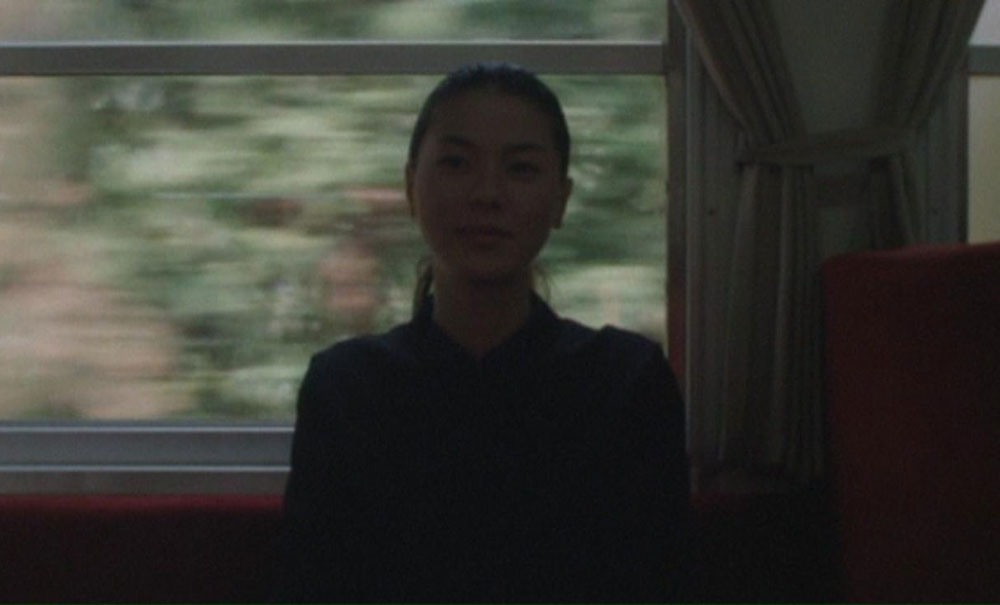Generally, anguish is expressed quietly in the films of Hirokazu Kore-eda, but ask the director to sit down to watch his first film “Maborosi” and you’ll be sure to hear about it.
“I just saw a little bit of it just now and I almost went home without doing this Q & A,” Kore-eda said through a translator, with a rare grin forming across his face at the end of a weeklong visit to Los Angeles last fall for the career retrospective “Cinema From the Outside In.” “Every shot seems beautifully and thoughtfully composed — it just seems like it was overdone. I can’t do much about it now… how I directed the kids. Seeing how they move in the scenes, I definitely would’ve allowed for a lot more freedom now.”
Of course, the director, widely considered to be Japan’s greatest contemporary auteur and known to be overly humble, may only be able to see what he perceives as its imperfections, but that would be overlooking a beguiling first feature that would be a career peak for most, an enigmatic drama about a young woman named Yumiko (Makiko Esumi), forced to carry on with her young child after her husband takes his own life for no obvious reason. An auspicious start for the filmmaker who would continue to find dramatic heft in weighing the memory of those people have lost against forging ahead in such films as “After Life” and “Our Little Sister, “Maborosi” is thankfully being put back into circulation on Blu-ray and DVD by the fine folks at Milestone Films after its initial New Yorker Films disc from 2000 went out of print, making it all but unavailable in North America.
The 1995 film is ripe for rediscovery, particularly when its release coincides with the American theatrical run in late July of Kore-eda’s rare foray into thriller territory with “The Third Murder,” which debuted at last year’s Venice Film Festival, and his latest film “Shoplifters,” which is primed to raise his international profile even further after recently winning the Palme d’Or at Cannes and is expected to be released later this year through Magnolia Pictures. While the themes of family and how those relationships can be reconfigured over time, especially when death is involved, that have been a hallmark of the director’s work are present in his debut, so to is the skill, summoning emotions that may be unexpressed verbally by the characters but can be divined by the way he can capture the energy in any room he puts a camera inside. As he explained to film critic Robert Koehler, who moderated the post-screening conversation following the screening of “Maborosi” at the Billy Wilder Theater at the Hammer Museum last fall, that faith in his own ability to set the mood may have given him the confidence to work with an untested lead actress in Esumi, who is unforgettable in as the newly widowed Yumiko.

Although “Maborosi” was based on Teru Miyamoto’s short story “Maborosi no Hikari,” Kore-eda had also taken inspiration from his own nonfiction work. He had spent a year with a widow working through her grief for the television documentary “Shikashi (However…)” after her husband, a government official overseeing a tragic case involving the illegal dumping of mercury into local tributaries, took his own life and was moved to write a book about it, which caught the attention of producer Naoe Gozu, who had picked up the rights to “Maborosi.” While the rights came cheaply – Gozu is said to have paid just $10 to acquire them from Miayamoto, who was slightly incredulous towards an adaptation of “Maborosi,” though he found great success before with Kōhei Oguri’s 1981 Oscar-nominated adaptation of “Muddy River,” neither the producer or director had made a narrative film before, so the odds were stacked against them.
“I felt nervous to be embarking on such a thing, but to go from documentary to the fiction world, it felt like somebody was telling me to do this,” said Kore-eda, who spent three years developing the project before the film got the greenlight.
Despite the fact that Esumi was another unknown in this equation, Kore-eda was determined to cast her after learning of the life experience she could bring to the role, drawing on her memories of losing her father to illness and surrounded her both onscreen and off with a veteran cast and crew. Kore-eda smiled reflecting on the time when he was the least seasoned member on set, trusting others with decisions he might make later in his career — and sometimes having no choice in the matter.
“The costume designer, Michiko Kitamura, is a very unique character and I really loved her,” said Kore-eda. “When I first met with her, she had all these pieces of fabric taped to the script for different moments through the entire script, and when I started to explain what I wanted for the film, she said, ‘Quiet.’ You don’t need to say anything. I know exactly what you want.
“This film is not about realism because you might say, oh in that small town, nobody would be dressed that way, but the colors did symbolize something and they were intentional. [Kitamura] had moments where dark blue symbolized something and red symbolized something — I don’t really remember what they symbolized now, but she spent three hours explaining what she had planned for the entire film and during those three hours, I probably spoke for only about five minutes! Another thing she said was, ‘By the way, all of my costumes I’m designing with the intention that this is natural lighting, so don’t use any lights, okay?’ [laughs] I prefer natural light and that’s how this film was designed, so I don’t think she would watch the film and have a problem with it.”
Speaking of audiences, Kore-eda also addressed a filmmaker’s question about whether he makes his films thinking about who they’re going to connect with, replying that he doesn’t give it much thought, but offered similar advice to what he received during his early days in television.
“What I was told by one of my co-workers or mentors at this TV production company was don’t think about such a big target, like an audience or the general public, because then the art is going to be diminished, said Kore-eda. “But if you just choose one single person – it could be your grandmother or your friend or your wife or someone and speak directly to them, that’s going to be the best thing to do. In the case of [“Maborosi”], I made it specific to speak directly to the woman I made the documentary about who lost her husband to a suicide.”
As noted by Koehler, “Maborosi” was an instant hit on the festival circuit, earning the Best Director prize at the Venice Film Festival where it first premiered, and established Kore-eda as one of the world’s great filmmakers. It also gave him a reputation for the types of stories he would tell, for better or worse. When Koehler pressed the director on the continuing motif in his work about “the way death and life haunts characters and families – there’s the memory of death as well as the reality of it,” that has run throughout such films as “After Life” and “Our Little Sister,” Kore-eda gave it more thought.
“There’s definitely themes that are similar so when I started going to film festivals, I was often introduced, even it would be printed above my photograph, “Death and Memory,” Kore-eda said with a smirk. “And I felt a little bit uneasy with that, but about half of my work has been based on original novels that exist and for some reason with the films that are based on those original novels are mostly [based on] that type of theme — it was the same with ‘Our Little Sister,’ which is a film about four girls who are brought together by their father’s death. It’s not exactly related directly to my own life, so I’m not really sure why I go there.
“But I feel like a lot of these films themselves and the characters are about speaking to the dead, so [in “Maborosi,” Yumiko] is thinking about the dead through the course of this film. It’s the same with “Still Walking” — they’re all aware of the brother that died. They compare the present moment to if he were alive. And in Japan, I feel that it’s not really about a belief in God necessarily, but a belief in the dead and how the dead watch us. That’s something I feel directly – that it’s like they are speaking to us all the time, and it’s not a scary thing and it’s not that they disappear when people die. Maybe it’s a different sense from a Western way of thinking about life and death, but the way I see it, death doesn’t begin and the end of life. It’s that life and death run parallel at all times. They reflect each other, so I live that way and I think that translates to my films as well.”




